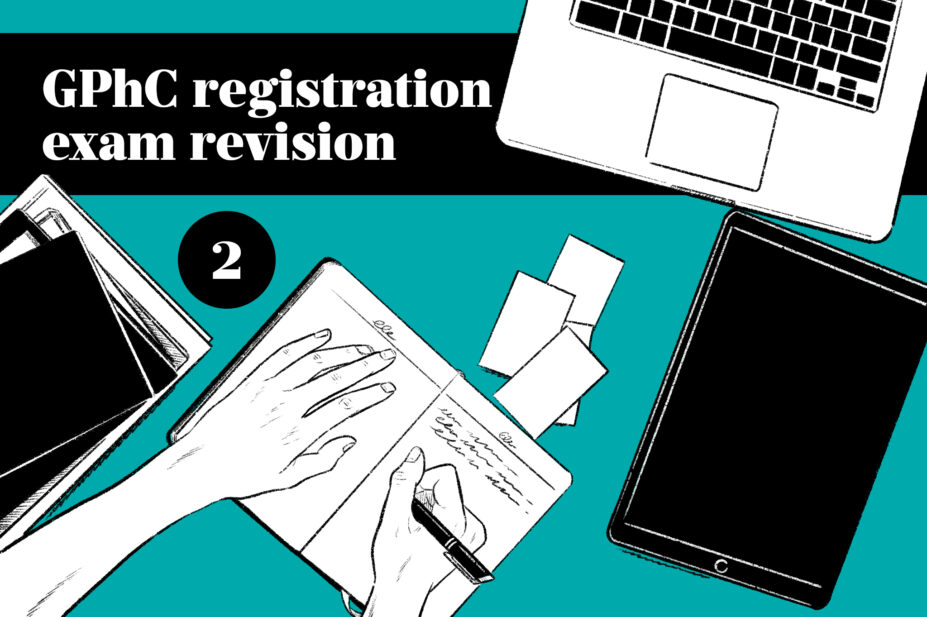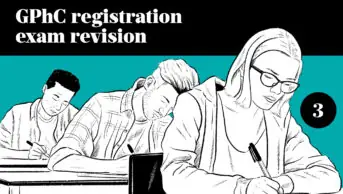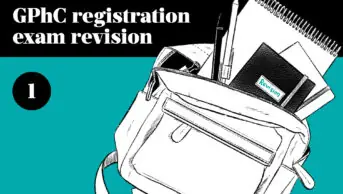
Wes Mountain/The Pharmaceutical Journal
By the end of this article, you should be able to:
- Use the question weightings to inform your revision strategy and allocation of time;
- Unpack individual future pharmacists’ outcomes from the GPhC assessment framework and use the indicative assessment topics to understand how outcomes are applied;
- Use relevant sources of information, policy and guidelines as part your preparation for the exam.
Introduction
In part 1 of this series, we focused on understanding the General Pharmaceutical Council (GPhC) framework and how you can apply it to various therapeutic topics. We discussed how learning outcomes are given different weightings to indicate the proportion of questions that will feature in the exam and the indicative assessment topics that can help you better understand the outcomes.
In this article, which is part 2 of the series, we will look at the framework more closely and explore how you can break down the respective outcomes and apply them to example exam questions. We will also direct you to important information sources and provide tips on how you can revise strategically. Although it is sensible to initially prioritise areas of the highest weighted sections of the GPhC framework, it is advisable to structure your preparation for the exam so that you revise all areas of the framework, including the medium-weighted (25% to 35%) content and, if time permits, the low-weighted (up to 10%) content, in that order[1].
This article will use a series of worked examples to look at three outcomes contained in section 10.1 of the framework — the expectations of a pharmacy professional. Highly weighted outcomes from section 10.2.2 will be analysed in the final article of the series. Please note that it is beyond the scope of this series to explore each outcome from the assessment framework in depth. The examples provided in these articles are intended to illustrate principles and methods that you can apply to the rest of the framework.
Worked example 1
How to meet the above outcome
To meet the above outcome, you should read the GPhC guidance on raising concerns alongside the GPhC standards for pharmacy professionals and the Public Interest Disclosure Act 1998 (PIDA)[2–4]. Standard 8 for pharmacy professionals states that “pharmacy professionals must speak up when they have concerns or when things go wrong”. The GPhC guidance for raising concerns advises that following an employer’s policy, concerns should be raised with the employer using their processes in the first instance before proceeding to the regulator or external organisations. If there is a risk of death or harm, you are required to report directly to the superintendent pharmacist, head office or pharmacy owner.
You may need to exercise professional judgement as to whether you should report internally or outside the organisation, especially if the cause of concern is someone to whom the pharmacist has strong loyalties, such as a line manager. Reading the GPhC guidance will help you to understand the importance of raising concerns. How concerns are raised is dependent on situations and the setting. You should also know where you can seek further advice, such as if your concern is about the pharmacy owner.
Exam questions on this outcome are most likely to test your professional judgement on whether you should report within the company/employer or externally. You will need to know the reporting process, what records to keep and the underpinning guidance of law that would inform your decisions. Most questions are written with the aim of bringing different pieces of knowledge together; for example, data protection and confidentiality. Below are some important documents that may help you to achieve the above outcome. We strongly recommend that you spend some time reading them in detail. Please note that this list is not exhaustive.
- GPhC guidance: Data protection and confidentiality;
- GPhC guidance on raising concerns;
- Public Interest disclosure (PIDA);
- Standards for pharmacy professionals;
- Royal Pharmaceutical Society (RPS): Medicines, Ethics and Practice (MEP);
- RPS pharmacy guide: ‘Raising concerns and whistleblowing’.
Example exam question
You are a locum pharmacist in charge of the pharmacy on a Saturday and standing in for the regular pharmacist manager who is on holiday. You learn that two of the three staff members who are actively dispensing prescriptions and selling various over-the-counter (OTC) products are not trained in healthcare or dispensary duties. In addition, they are not enrolled on any training course. They tell you that “everyone who recently joined this company is still waiting to be enrolled on the course and that the owner (superintendent pharmacist) is aware”.
Who is the most appropriate person or organisation to raise your concerns with?
A: The GPhC
B: The superintendent pharmacist or owner
C: The integrated care system or local health board
D: The police
E: The regular pharmacist manager
ANSWER = B is the most appropriate answer.
Discussion
This is a challenging scenario and one that requires careful application of professional judgement and underpinning knowledge. At first glance, it may appear that reporting to an external organisation may be appropriate, assuming that the staff workers are telling the truth, in which case you would be inclined to report to the GPhC. With no absolute certainty on what you have been told, it would be most appropriate to report this to the superintendent pharmacist or owner and only escalate to the GPhC if the issue is unresolved. It would not be the best option to report to the police or integrated care system or local health board as no crime or breach of the pharmacy contract has occurred. Reporting to the regular pharmacy manager may not yield the desired outcome as they do not own the pharmacy. The most appropriate answer is B. Note that with single best answer questions, the answer may not necessarily be 100% right but should be better than the other options. Equally, the other options may also contain elements that are right in some ways but, based on the information contained in the question, do not stand out as the single best answer (SBA).
Worked example 2
How to meet the above outcome
The above outcome requires an understanding of the principles of clinical governance, how they are embedded in healthcare settings and what you can do to be part of it. We would recommend reading the guidance documents listed below. You should then be able to answer the following questions:
- What is clinical governance?
- Who is clinical governance for?
- What is the purpose of audit, and can you give a few examples of audit in your work area?
- What is clinical effectiveness?
- What are the revalidation requirements for pharmacists stipulated by the GPhC and why is continuing professional development (CPD) important?
- What do you do to involve people who use your services?
- How do you manage staff, risk and private information (GDPR/data)?
Taking the final question as an example, according to the GPhC, risk management in the context of registered pharmacies is more than just focusing on near misses and dispensing errors and involves[5]:
- Having the necessary systems, processes and skilled staff in place to minimise the likelihood of providing poor quality care;
- Having mechanisms to learn from situations where, despite having those systems something has gone wrong;
- Identifying and minimising the potential for harm or adverse health outcomes if something goes wrong because of a pharmacy’s activities and services.
Within the pharmacy context, think of near-miss logs and how errors that have reached the patient are managed. Are you familiar with concepts such as root-cause analysis and the Patient Safety Incident Response Framework? What does the pharmacy do to reduce or minimise errors in dispensing and processing prescriptions or selling OTC medicines? What about indemnity insurance arrangements, use of standard operating procedures (SOPs), CPD and keeping up to date? All of these areas form part of clinical governance, and you should be confident about what is involved in each component. The resources below may be useful for enhancing your knowledge in clinical governance.
- RPS pharmacy guide: ‘Clinical governance‘;
- Community Pharmacy England: ‘Clinical governance‘;
- Community Pharmacy Wales: ‘Clinical governance‘;
- RPS: MEP section 2.5, ‘Patient Safety‘;
- GPhC: ‘Revalidation for pharmacists’.
Example exam question
It is time for pharmacists to complete revalidation requirements to remain on the register. You work for the GPhC as a CPD revalidation officer, and you have just reviewed records A to E in the options below.
Which one of the records A to E is most likely to meet the minimum revalidation requirements?
A: Four planned CPD + 2 peer discussion+ 1 reflective account
B: Four unplanned CPD + 2 peer discussions + 1 reflective account
C: Three unplanned CPD + 1 planned CPD + 1 peer discussion + 1 reflective account
D: Three planned CPD + 1 unplanned CPD + 1 peer discussion + 2 reflective accounts
E: Two planned CPD + 2 unplanned CPD + 1 peer discussion + 1 reflective account
Answer = E meets the requirements.
Discussion
This question is testing your knowledge on clinical governance and specifically looking at the GPhC revalidation requirements for pharmacists[6]. Please note that any other components of clinical governance can equally be asked in the exam, so it is important to know what all the components are and how they work in practice. Relying on factual recall does not help you to answer this type of question. The answer options have been worded such that there is need to understand the revalidation requirements and then apply them to the given scenario.
According to the GPhC, for revalidation purposes, pharmacy professionals must submit the following records each year[6]:
- Four CPD records (at least two of which should be planned);
- A peer discussion;
- A reflective account.
Looking at the options A to E, only option E has four CPDs with at least two planned CPDs, a peer discussion and a reflective account.
Worked example 3
How to meet the above outcome
The above outcome can be met by reading the appropriate guidance from the National Institute for Health and Care Excellence (NICE), the relevant Clinical Knowledge Summaries (CKS) and other guidance for common medical emergencies in the community[7–10]. This may be supplemented by basic life support (BLS) guidance from the UK Resuscitation Council. For prescribing information for the common drugs used, you should consult the British National Formulary (BNF) and summary of product characteristics from the electronic medicines compendium. The common topics that you can focus on include adrenal crisis, acute coronary syndromes, acute asthma attack, anaphylaxis, bacterial meningitis, hypoglycaemia, seizures, burns and sepsis.
If a patient develops symptoms of adrenal crisis, you should be able to identify the diagnostic features and assess the patient in the following order, A (airway), B (breathing), C (circulation), D (disability), E (exposure), and call 999 immediately stating “Addisonian crisis”. If the patient’s emergency hydrocortisone injection kit is available, you should administer intramuscular (IM) hydrocortisone. You should also know how to respond if a patient presents at your pharmacy with signs and symptoms suggestive of sepsis, anaphylaxis, hypoglycaemia, seizure or an asthma attack.
The list below contains further resources that will enhance your knowledge in this area:
- BNF online;
- Europe PMC: ‘Medical emergencies in the dental practice poster: revised and updated‘;
- Resuscitation Council UK: Resuscitation guidelines;
- Resuscitation Council UK: Anaphylaxis guidelines;
- Resuscitation Council UK: ‘Anaphylaxis algorithm‘.
You should be aware that any of the emergency conditions stands an equal chance to be asked in the exam, so it is best to prepare for all the common emergency conditions. Rare conditions are least likely to be tested.
Example exam question
You are part of the vaccination team at the GP practice where you work as a pharmacist independent prescriber. You have just administered an influenza vaccine to a 45-year-old woman. Five minutes later, while seated in the waiting area, she develops the following signs and symptoms:
- Skin itchiness;
- Pallor and flushing;
- Cough;
- Wheeze and stridor;
- Ten achycardia with weak pulse.
What is the best next step?
A: Reassure the patient and advise that it is a rare side effect to the influenza vaccine
B: Administer adrenaline and call 999
C: Give patient high flow oxygen and monitor symptoms
D: Give patient hydrocortisone (IV) and call 999
E: Give patient oral glucose and monitor blood sugar levels
Correct answer = B is the best next step.
Discussion
Option A is partly correct in that the symptoms are a rare side effect of the vaccine; however, only providing reassurance to the patient does not equate to the best answer as it does not respond to the danger facing the patient.
Option B is the most appropriate because the signs and symptoms and time of onset suggest anaphylaxis. According to the BNF online, adrenaline at a dose of 500 micrograms (0.5 mL), should be given and repeated after 5 minutes if necessary. An ambulance should be called to take the patient to hospital.
Option C is partly correct in that high-flow oxygen may be used; however, the context and setting make this unlikely to be the single best answer. In a hospital setting, oxygen can be given, but in the community setting described in the question, adrenaline (IM) would be the best next step with further treatments in hospital if necessary.
Option D is partly correct in that hydrocortisone (IV) may be used; however, the context and setting make this an unlikely intervention. In a hospital setting, hydrocortisone (IV) can be given, but in a community setting, as described above, adrenaline (IM) would be the best next step with further treatments in hospital if necessary.
Option E is incorrect. This option may appear plausible if candidates do not know the difference between the signs and symptoms of hypoglycaemia compared with those of anaphylaxis.
Summary
This article has shown how it is possible to apply elements of the GPhC assessment framework and indicative assessment topics to sample exam questions and link them to key themes contained in the outcomes described in section 10.1. We have specifically focused on some low- and medium-weighted outcomes. It is important not to neglect these when planning your revision time. It is also important to note that topics related to conditions that are commonly encountered during practice are most likely to appear in the exam. In the next and final part of this series, we will focus on the highly weighted section 10.2.2 of the GPhC assessment framework, where we will provide similar worked examples to show how you can approach this section of the framework and apply it to key therapeutic topics.
Disclaimer and acknowledgements
The views in this article are our those of the authors and do not represent the views of any organisations they are associated with. The questions and explanations presented here are for educational purposes only and do not replace your training, knowledge and application of professional judgement as a pharmacist or trainee pharmacist. The example questions used in this article and the answers provided are for educational purposes and should not be translated to represent what would happen in real practice.
All practice questions were reproduced with kind permission provided by: Focus Pre-Reg Revision https://focuspreregrevision.wildapricot.org/
RPS revision course with mock assessment
This course is designed for all foundation trainees sitting their General Pharmaceutical Council (GPhC) registration assessment in summer or autumn 2025.
Available exclusively to foundation trainee RPS members as part of their membership, revision webinars start in March 2025 and booking is now open for trainees to secure their place.
- 1Registration assessment framework. General Pharmaceutical Council. https://www.pharmacyregulation.org/53-registration-assessment-framework (accessed April 2024)
- 2In practice: Guidance on raising concerns. General Pharmaceutical Council. 2020. https://www.pharmacyregulation.org/sites/default/files/document/in-practice-guidance-on-raising-concerns-november-2020.pdf (accessed April 2024)
- 3Standards for pharmacy professionals. General Pharmaceutical Council. https://www.pharmacyregulation.org/standards/standards-for-pharmacy-professionals (accessed April 2024)
- 4Public Interest Disclosure Act 1998. legislation.gov.uk. 1998. https://www.legislation.gov.uk/ukpga/1998/23/contents (accessed April 2024)
- 5Focus on risk management in pharmacy. General Pharmaceutical Council: Regulate. 2016. https://www.pharmacyregulation.org/regulate/article/focus-risk-management-pharmacy (accessed April 2024)
- 6Revalidation for pharmacists and pharmacy technicians. General Pharmaceutical Council. https://www.pharmacyregulation.org/revalidation (accessed April 2024)
- 7Medical emergencies in the community. British National Formulary . https://bnf.nice.org.uk/treatment-summaries/medical-emergencies-in-the-community/ (accessed April 2024)
- 8Clinical knowledge summaries . National Institute for Health and Care Excellence. https://cks.nice.org.uk/ (accessed April 2024)
- 9Jevon P. Medical emergencies in the dental practice poster: revised and updated. Br Dent J. 2020;229:97–104. https://doi.org/10.1038/s41415-020-1789-y
- 102021 Resuscitation Guidelines. Resuscitation Council UK. 2021. https://www.resus.org.uk/library/2021-resuscitation-guidelines (accessed April 2024)
You might also be interested in…

Hospital pharmacist trainees more likely to pass registration exam than community trainees, finds analysis

Preparing for the GPhC registration exams: how to revise learning outcomes relating to clinical knowledge and therapeutic approaches

